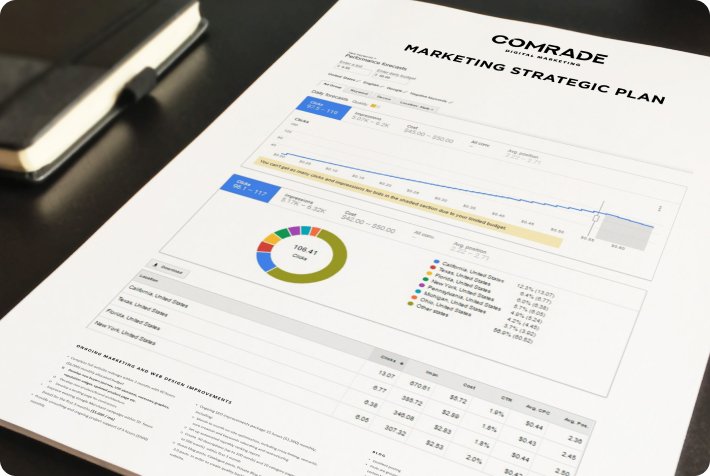How can PPC help your business? Your eCommerce website is not the only place to sell your products online. PPC affords access to platforms like Google, Amazon, Bing, and others to reach potential customers. Best of all, 64% of people click on PPC ads over organic search results, which means PPC delivers a substantial infusion of traffic to your eCommerce website.
What Is eCommerce PPC?
eCommerce PPC advertising is a digital advertising method in which a company pays an ad publisher for each user who clicks on its ad. Although the term “pay per click” is commonly used to refer to search engine ad platforms such as Google AdWords, this business model is used by a wide range of marketers.
Is PPC Good for Ecommerce?
Pay-per-click is one of the best marketing tactics, and as such, can provide a significant positive impact on your business.
eCommerce PPC campaigns play a vital role in your advertising strategy, so it’s critical that you comprehend the benefits PPC for eCommerce may provide your business.
Is PPC Better Than SEO?
There are several crucial variables to take into account when deciding how to use your efforts and digital advertising spending, including the difference between PPC (pay-per-click) advertisements and SEO (search engine optimization).
PPC advertising, like Google Search Ads, is paid online ads that enable companies and site operators (like you!) to compete for the opportunity to show an advertisement beside searches on Google. SEO upgrades, on the other hand, can enhance your website’s rank on Google Search by proving you provide more value to visitors. Both are important and should be used in tandem in your marketing campaign for the ultimate leads boost.
Is ecommerce PPC Management Hard?
PPC management requires a lot of effort and money. But why is PPC management so hard? This is one of the most common questions we get.
First and foremost, determining the pros and cons of the platforms takes time, as does keeping abreast of any algorithm and market changes that can have an influence on your efforts. It’s a sad reality that, occasionally, campaigns simply fail for no discernible reason.
How Do Ecommerce PPC Management Works?
Unlike traditional marketing, in eCommerce PPC business only pays when the ad is clicked. The aim of pay-per-click advertising is to lead the user to the advertisers’ website where they can complete a valuable action like purchasing a product or service.
Data-Driven Content Marketing
eCommerce PPC marketing leverages the power of social media platforms, search engines like Google and Bing, as well as e-commerce platforms where you can place your ads like Amazon ads or Google shopping ads. eCommerce PPC advertising campaigns are based on data-backed research, using appropriate keywords, as well as selecting the right assets for each platform and target market to attract referrals and increase click-through rates.
PPC Tracking
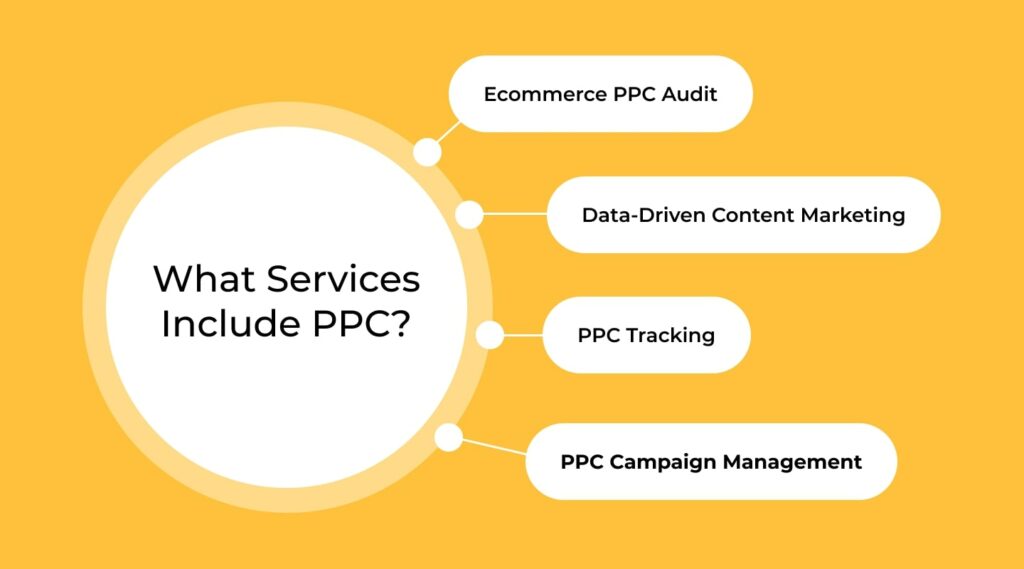
A variety of eCommerce PPC tools can be used to track the success of your campaigns and analyze where they can be improved. Professional digital marketing teams monitor each campaign’s average ad position, click-through rate, cost-per-click, as well as leads, calls, and sales. Also, PPC strategies should attribute revenue to each paid campaign to assess your ROI and monitor these metrics regularly.
PPC Campaign Management
eCommerce PPC campaign management entails managing and tweaking bids, monitoring key search queries, rolling out a/b testing, and account restructuring. Achieving the best results requires continuous development, testing, and reporting on your campaign performance. eCommerce PPC experts provide custom reports detailing your growth metrics and revenue goals. constant improvements will allow your business to unlock the right formula to keep your ROI high and spend low.
Types of PPC Ads
PPC campaigns return roughly $2 for every $1 producing a 200% ROI. Consequently, they are an invaluable online advertising tool for businesses looking for increased brand awareness, traffic, and lead generation. There are several types of PPC ads available in a variety of formats designed to show up in different places to advertise your business online.
Text-Only Ads
Text ads appear at the top and bottom on Google’s search results pages and throughout the Google Network, i.e., on other search sites that partner with Google to show ads. These types of PPC ads have three parts: a display URL, headline text, and description.
Product Shopping Ads
Google Shopping ads are displayed at the top of search engine results pages when shoppers search terms that indicate they’re looking for specific products. These ads contain product information such as color, size, prices, the seller, and photos.
Showcase Shopping Ads
Showcase Shopping ads appear in a carousel in Google’s web search when customers type in generic product terms. Unlike standard Product Shopping Ads, when clicked on, Showcase Shopping ads expand into a popup on desktops and a new panel on mobile devices showcasing all related products from a store’s product category.
Call-Only Ads
As its name suggests, call-only ads are designed to encourage people to call your business and only appear on devices that make phone calls. When a potential customer clicks on your ad, it places a call to you from their device. Call-only PPC ads work well for local service businesses.
Responsive Ads
These ads automatically optimize their appearance on different devices for more conversions. For instance, while they might appear as text-only ads on mobile devices, on desktop screens they display as larger banner ads.
Image Ads
With these ads, you can include visuals to showcase your brand or product, to make them more visually appealing to potential customers. You can use static, HTML5, GIF and even Flash formats to create animated or interactive ads.
Video Ads
Paid video advertising on YouTube and the Google Display Network is an excellent way to boost brand awareness, considering that 78% of consumers watch online videos every week. If you have promotional video material, you can run videos either as standalone ads or embed them into streaming video content. Non-skippable ads, TrueView ads and Bumper ads are the three main advertising options available for embedded YouTube video advertising.
Google Maps Ads
Also known as Local Search Ads, these appear when you perform a location search on the Google Maps app. Displaying your business’s ad in map form alerts potential customers to the exact location of your business which gives you a competitive advantage if it’s closer and thus more convenient than other businesses.
App Promotion Ads
App campaigns allow you to promote your app across Google Search, Google Play, YouTube, Gmail, and within other apps and mobile websites on Google’s Display Network. Keep in mind these types of PPC ads only work with devices compatible with the Google Play Store.
PPC Benefits for eCommerce
PPC is a powerful tool every eCommerce business should learn how to leverage. PPC is a terrific complement to long-term strategies like SEO, as it generates results relatively quickly. Best of all is PPC’s cost-effectiveness. Businesses only pay when a prospect has actually clicked on their ads, meaning there’s no waste. On average, PPC and retargeting campaigns yield positive results for businesses, far outpacing traditional methods like print ads.
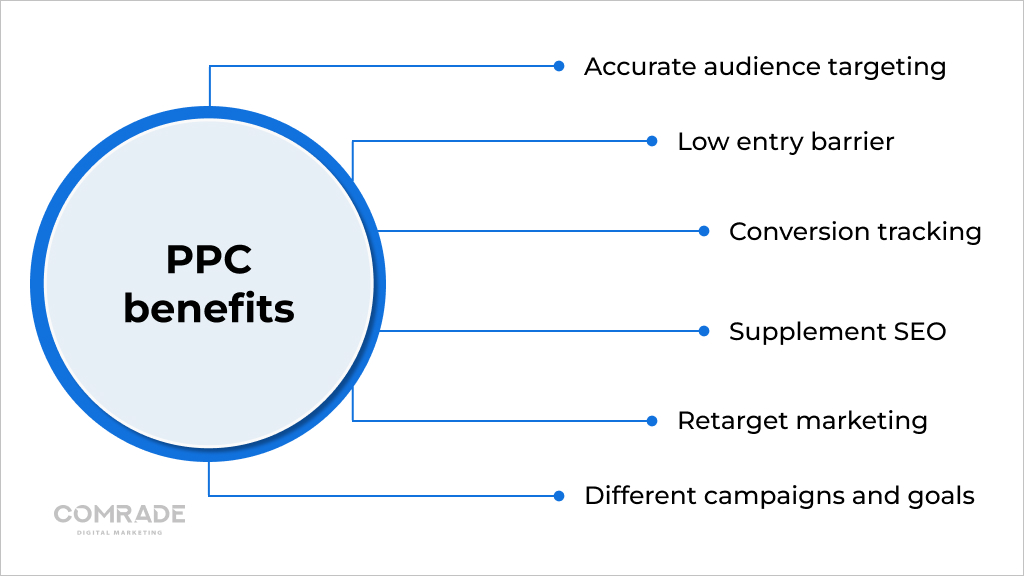
Low Entry Barrier
Businesses that are just starting out often don’t have huge marketing spending. Entering digital marketing via PPC is relatively easy as it requires less time, effort, and money. If managed correctly, PPC can offer smaller businesses a higher ROI when compared to other forms of marketing and add tremendous value to others who already have a larger marketing budget.
PPC is driven by data-backed strategies, and everything is measurable through analytical tools and conversion metrics. Campaigns can be optimized and can spend adjusted accordingly, meaning that if data reveals a campaign to be successful, spending can immediately be boosted. A Low PPC budget opens a new way for businesses with limited finances to a significant degree of control because they don’t pay for ad impressions or reach, only clicks.
Accurate Audience Targeting
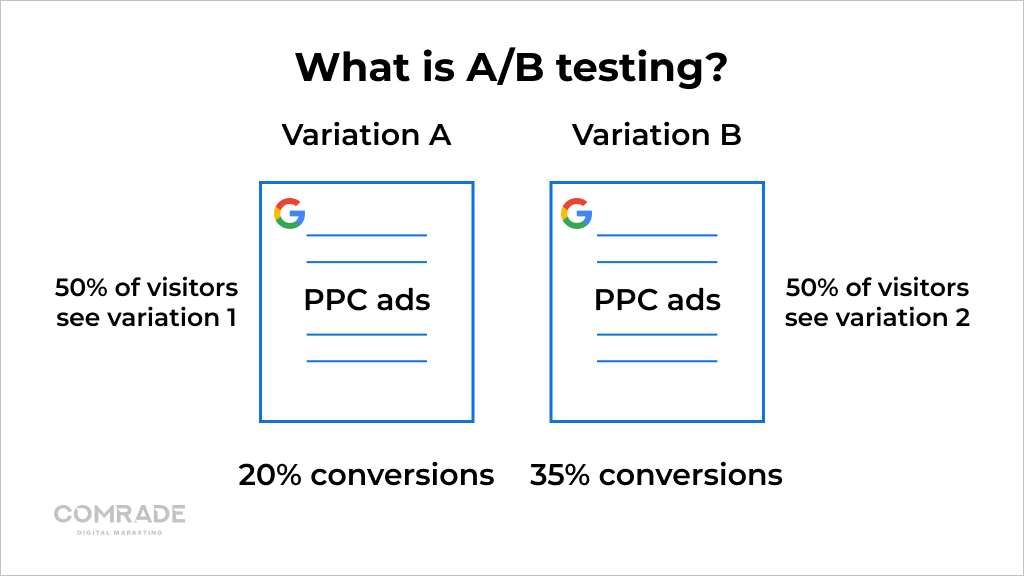
Through A/B testing it’s possible to only target the most relevant audience, i.e. those who search for the same keywords in advertisements. When someone clicks on an advertisement, it is intentional and never coincidental and proves they are further down the buyer’s funnel.
PPC advertising also provides greater control over advertising because marketers can choose when and where it appears, offering a wide range of influence on targeting an audience relevant to what a business offers. Once a business understands its target audience segments, it can optimize its campaigns to correlate with its audience’s online behavior.
Supplement Search Engine Optimization (SEO)
PPC campaigns help an eCommerce store with its long-term SEO strategies. A/B testing is a common PPC practice. It entails the process of comparing two variations of the same advertisement by testing the target audience’s response and concluding which of the two is most effective.
When done correctly, it shows which advertisements get the most interest both through clicks and impressions. These data points can help refine a marketing plan’s overall SEO strategy and point towards new possibilities.
Different Campaigns and Goals
With PPC, there are various campaign types to choose from to promote products and businesses. Campaigns can be tailored to drive sales, gather leads, send traffic to ecommerce sites, create product and brand awareness, and fuel app downloads.
These campaign goals can be achieved through different advertisement types such as; search and display, social media, local service, Google ads, Gmail sponsored promotions, and Instream ads, to name a few. With PPC, there are so many ways to promote brand awareness and increase leads.
Retarget Marketing
It’s normal for some target audiences to leave eCommerce websites without taking action. PPC makes it possible to retarget these users and show them revised advertisements that may pique their interest. Being exposed to another advertisement gives an ecommerce store another chance to convert leads into customers.
Retargeting is effective because users are already interested in the business’s products or services but might need more time to decide. It allows marketers to retarget advertisements that are specific to users, yielding higher conversion rates.
Conversion Tracking
Every aspect of pay-per-click advertising can be tracked and measured, which makes calculating ROI easy. When advertisements can be measured, they can be improved and optimized. PPC offers a wealth of valuable data like impressions, clicks, and conversion rates for each keyword.
They allow eCommerce businesses to understand exactly what their customers are looking for and what makes them most likely to convert at every stage of the buyer’s funnel. PPC provides instant results and feedback, so landing page copy, keywords, and visual assets can be constantly tweaked to reach the best results.
7 Best eCommerce PPC Strategies for Growth
The beauty of PPC for ecommerce is that nothing is set in stone. Not your keywords, not your budget not your ad copy. It’s possible to tweak your campaigns at any time, so if they’re underperforming, don’t worry. Here’s how to fix them and dramatically improve ROI:
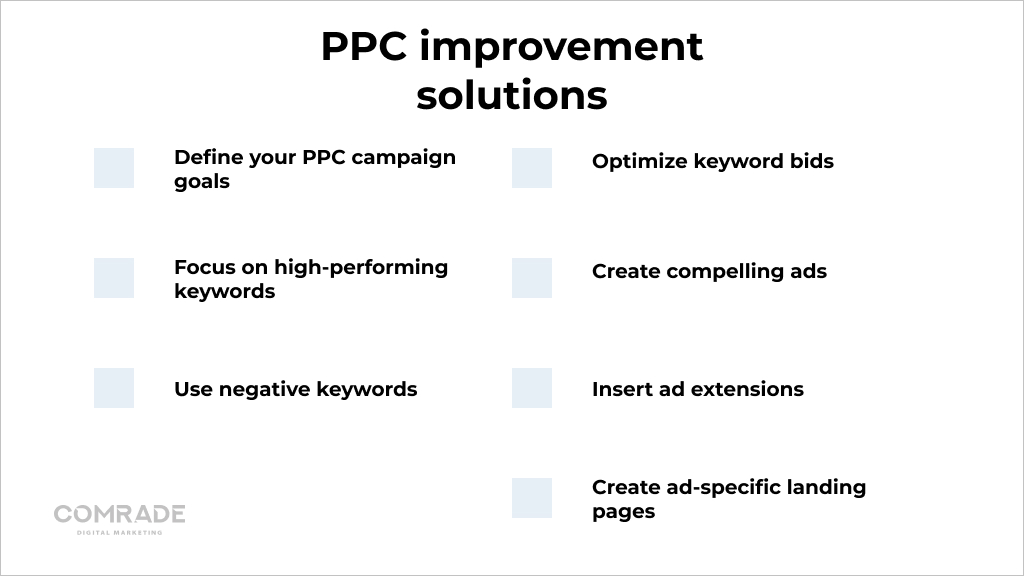
1. Define Your PPC Campaign Goals
All advertising campaigns need a goal. If you don’t know what you’re working towards you won’t know whether your conversion is high enough or if your keywords are working. With Google Ads, you can set three different goals:
- Improve website traffic;
- Generate more leads; and
- Drive sales
While each campaign can only have one goal, there’s nothing stopping you from running multiple campaigns at the same time!
2. Focus on High-Performing Keywords
Because high-performing keywords satisfy a combination of high impressions, good click-through rates, and high conversion rates, they generate the most sales and traffic. High-performing keywords aren’t always high volume.
Sometimes low-volume keywords provide opportunities to build interest around a new niche or target topic relevant to your audience. Using Google Keyword Planner, Moz, Ahrefs or UberSuggest can help you find the right combination of keywords to increase conversion.
3. Use Negative Keywords
Logic dictates that once you know which keywords work, you’ll instantly see which ones don’t fit. You want to filter out keywords that generate traffic but not conversions. For example, let’s say you’re a barber. You’ll want to filter out “woman’s hairdresser near me,” because it targets the wrong audience.
You can find negative keywords using the Google Ads Keyword Planner. Keeping a list of negative keywords ensures you won’t waste time or money reaching out to people you know aren’t interested in what you have to offer.
4. Optimize Keyword Bids
Optimizing your keyword bids can significantly lower your cost of customer acquisition. You can control bidding manually or use an AI tool that considers both the market and your budget to optimize your bidding strategy. We’d recommend using manual bidding because it’s more customizable.
While automated bidding removes the heavy lifting from PPC, it usually targets an overly broad audience, which can lead to overspending and ultimately hurt your ROI. Yes, manual bidding is more hands-on, but it gives you more control to adjust your bids to meet campaign goals, thus maximizing conversions and sales.
5. Create Compelling Ads
Good ads offer something compelling and look professional. If your ad is attractive, then you’ve won half the battle. Including high-quality product photos, and keeping copy short and concise is best. Generally, there are two ways to make your ads click-worthy.
Either they have emotional appeal or they win over customers due to advertising competitive pricing. Sometimes, they do both. Nobody clicks on an ad because they think it’s cool, they click on it because the product or service advertised might solve their problem. Keep this in mind when crafting your headlines and ad copy.
6. Insert Ad Extensions
Ad extensions are extra information that’s displayed below your ad copy. Location extensions, for example, allow you to include your phone number and contact details, while message extensions make it easy for prospects to get hold of you.
It’s even possible to include price extensions which show customers the cost of products they’re interested in. These little details can become the differentiating factor between you and your completion.
7. Create Ad-Specific Landing Pages
Finally, remember to create landing pages with strong calls to action that are specific to each ad. Ensure the page continues the theme of the advertisement and doesn’t direct your target audience to something irrelevant—this just erodes customer trust. If someone clicks on an ad for an office desk, make sure the landing page features that desk!
Budget-Friendly Tips for eCommerce PPC Ads
We can’t stress these tips enough!
- Be realistic. If you’re running PPC ads in a competitive industry with highly sought-after keywords and many big brands, you’re going to need a substantial marketing budget.
- Be aware of keyword competition. If you’re unaware of keyword competition, you risk two extremes; underspending, so your ads don’t run, or overspending to achieve the desired result. Neither of these is optimal.
- Make sure your PPC ad has a corresponding landing page. It’s not a good idea to make the destination of your PPC ad your website’s homepage. Imagine your customers click on an ad for patio furniture only to be taken to a general home page, and not a product page of the furniture they’re interested in.
This creates unnecessary friction during the buyer’s journey. Always make sure you’re sending new customers to a destination that helps them find what they’re looking for. This is known as “intent match,” which is highly favored by search engines.
3 Common PPC Ecommerce Issues and How to Solve Them
When PPC campaigns don’t get results it’s usually because there’s an issue with ad configuration or the actual advertising strategy. Avoiding the mistakes below will bring you closer to reaching your marketing goals and improve ROI.
1. High Traffic but a Low Conversion Rate
There are two major reasons for a high click-through rate but low conversions. Either you’re ranking for the wrong query or your landing page content doesn’t connect with your ad copy.
Reason One: The Wrong Keywords
Did you research keywords properly before starting your PPC marketing campaign? The biggest mistake so many businesses make is skipping keyword research and only using high-volume phrases. Remember, campaign keywords don’t need to be popular to be relevant.
Reason Two: Disconnected Landing Pages
Your landing page should have a clear call to action, look professional and deliver what potential customers want and expect. Too often, eager customers will click on an enticing ad only to land on a business’s homepage, which makes them less likely to convert. The same can be said about landing pages that resemble spam websites with poor graphics and design.
2. Poor-Quality Scores
Google AdWord’s PPC Quality Score is a rating system that determines the relevancy of your ads using three factors; expected click-through rate, ad relevance and landing page experience. A low-quality score is anything below 6/10 and indicates there’s room to improve your PPC campaigns.
It’s quite normal for most PPC ads to perform differently for each of the above-mentioned factors, so long as you have a good average Quality Score as this will determine the success of your PPC campaigns.
3. Using Too Many Keywords
Using too many keywords can sabotage your ad rank by reducing the relevance of your ads. A higher number of keywords without the right Ad grouping confuses search engines as they won’t know which phrases you’re prioritizing.
Keywords must be perfectly segmented based on user intent and the stage in the customer’s buying journey. Having a clearly defined account structure with the correct segmentation improves relevance and thus ad rank. Therefore, it’s far better to rank for a concise group of keywords than as many as possible. In this case, less is more.
How to Calculate the Right PPC Budget for Maximum ROI
Setting the right eCommerce PPC budget can be challenging. Too little and you run the risk of not seeing enough volume to reach profitability. Too much and you’ll likely overspend without making meaningful gains. So, how do you set the right budget for your PPC ads?
Here’s the catch: What you spend on ad campaigns shouldn’t be a static number. Goals and budgets change. And while there isn’t a definitive answer, there is a profitable methodology that ensures your marketing spend returns the highest ROI.
Whether you’re just starting to invest in pay-per-click advertising or need to optimize your current eCommerce PPC strategy, this quick guide will show you how to get the most from your PPC marketing budget.
How to Calculate eCommerce PPC ROI
Will the total revenue generated from your PPC ads be worth the cost? If you structure your digital marketing budget correctly, adhere to search engine optimization basics and create good ads, you should generate a great return on your PPC campaigns. Better yet, you can also hire an eCommerce marketing agency to manage your pay-per-click marketing strategy.
In the meantime, to calculate ROI use this formula:
- ROI = (Revenue – Cost of Goods Sold) / Cost of Goods Sold.
What is a good ROI for eCommerce companies? Technically, there’s no right answer, so long as you’re not spending more money than you’re making. BigCommerce has found an average benchmark for Return on Ad Spend (ROAS) across industries is 4:1—$4 revenue for every $1 in ad spend. However, start-ups sometimes have higher margins, while online stores with aggressive growth strategies might be able to afford higher advertising costs.
Remember, with PPC ads, you only pay for performance (hence pay-per-click) and with adequate testing and adjustments, you’ll always be able to make sure your performance is in line with your business goals.
How Your Ecommerce PPC Budget Influences Campaign Performance
Let’s start with the basics. PPC marketing uses an auction-based system to determine the relevance of your ads and decide where they show up in search engine results and across the Google Network.
The PPC process works as follows:
Once your ad is created and approved, it goes through an auction process. During this stage, the Google Ads system places your ad in a pool with other ads targeting the same keywords. Google automatically ignores any ads that aren’t eligible such as those targeting a different geographical region. Next, it analyzes your ad’s “Ad Rank” and only displays those that rank the highest.
Ad Rank is Google’s way of determining the ordering of competing ads on a search engine results page (SERP). According to Google, “Ad Rank is calculated using your bid amount, auction-time, ad quality, Ad Rank thresholds, the competitiveness of an auction, the context of a person’s search, other ads, and the expected impact of assets and other ad formats.”
Here’s the kicker—even if you get outbid on a particular keyword, you can still rank higher in an auction by winning a higher position at a lower price if your ads are relevant and well-made.
How Does the PPC Bidding Process Work?
Pay-per-click bidding involves advertisers bidding for specific keywords or keyword groups in an attempt to secure ad space for important terms relevant to their business. This means eCommerce businesses compete to win the best spot, and usually, the highest bidder wins.
When you start a PPC campaign, Google will ask you what the maximum amount is that you’re willing to pay each time a user clicks on your ad. Remember, with PPC you only pay when users click through to your website or landing pages.
The tricky part is there’s no way of knowing if what you’re suggesting will be higher or lower than other companies’ bids for the same keywords. Inevitably, there is a degree of trial and error. Over time, you’ll begin to notice patterns and develop a better idea of how much your eCommerce marketing budget needs to be to reach the right customers.
Keeping a watchful eye on campaign performance and using analytics will help you calibrate your campaigns correctly. There’s no set bidding amount as keyword popularity and competitiveness varies from industry to industry.
The Ideal Budget for an eCommerce PPC Campaign
To extrapolate on the previous point; the ideal amount of money you spend on PPC ads varies widely and depends on numerous factors. These include your sales goals, the size of the geographic area you’re targeting, the search volume of your chosen keywords, and the overall competitiveness of the industry you’re in.
Your ad spend could be as low as $50.00 per month or as high as $10.000 or more! Therefore, instead of selecting a ballpark figure, it’s more cost-effective and strategic to determine your campaign goals first and then set aside a marketing budget based on what you’re attempting to achieve.
Compare Your Business Goals with Your Potential Budget
An eCommerce marketing budget doesn’t operate in a silo. Small businesses usually spend 7% to 8% of their revenue on marketing and mid-sized businesses spend at least 10%. Of that percentage, you can expect to pay roughly $1.000 to $2.000 for an effective PPC campaign.
Generally, companies pay $1-$2 per click to market on the Google Search Network. But again, these numbers aren’t set in stone, which is why it’s important to set clear goals. For example, let’s say your goal is to make $2.000 in profit each month from your PPC campaign. You can then work backwards to figure out what your required marketing budget is.
If you know your average order size is $50, the conversion rate is 5%, and the average cost per click is $2, then for every 1,000 people who visit your website each month, 100 make a purchase which equals $2.500 in revenue.
However, you’ve had to pay $2.000 for those clicks. Therefore, you’ve only made a $500.00 profit. Now you can work out how much you actually need to spend to reach your KPI.
There are other factors to consider as well. How much of your digital marketing strategy consists of PPC? Do you want to supplant other marketing channels or are you simply looking to supplement them with additional online traffic? These variables all play a part in determining not just your PPC spend but also your entire marketing budget.
Use Google Keyword Planner to Determine Your PPC Budget
As we mentioned earlier, Google’s Keyword Planner can help you find relevant keywords, as well as determine what their search volumes and cost-per-click are. It’s crucial you know how much a keyword costs; otherwise, you’re shooting blind. For instance, the cost-per-click for the keyword “mortgage” is $47!
Undoubtedly, your digital marketing goals and the price of keywords will influence your PPC ad copy. To mitigate the expense of high-volume and competitive keywords, most businesses use a combination of keywords that attract buyers at different stages of the sales funnel.
Also bear in mind that while that cost-per-click may seem astronomical, if a company makes a few thousand dollars from a client or customer who clicks on their ad, then it’s worthwhile. So, as you can see, marketing budgets for PPC are totally industry-dependent.
Nevertheless, back to keywords. If your plan is to generate leads, then you’re probably going to use top-of-the-funnel keywords. However, if you want to drive sales, you’ll want to invest in “high-intent” keywords that include words like “buy,” “discount,” “free shipping,” etc.
Once you decide on your keywords, Google Keyword Planner will generate “Your Plan” to help you work out your budget. You really want to use Google Keyword Planner to gather as much information as possible. And not only that, but Google actually wants you to be successful because the better your PPC ads perform, the more money you’ll have to spend.
How A/B Testing Ensures a High PPC ROI
A/B testing, also known as split testing or bucket testing, is a method of comparing two versions of the same PPC ad (with different variables) to determine which performs better. These tests are crucial and standard practice to ensure long-term campaign success.
For example, you might decide to change an ad’s headline copy or image. Just remember that you should only test one variable at a time. If you change both the image and the headline, you won’t know which one is actually influencing results.
You’ll also want to make sure your Google Analytics is set up, and you’re able to track conversions from your ads via the correct Google tags on your site. The point of A/B testing is to make your pay-per-click ads as optimized as possible. The better your ads perform, the higher their Quality Score and the lower their cost-per-click.
If your goal is to increase sales, you’ll need to test your ads for the entire duration of your sales cycle. If you’re just looking for leads, A/B testing likely won’t take as long. Your testing time also depends on your overall budget and industry. Companies with small budgets should test for longer to get reliable data that’s actionable.
For Better Results Hire a Professional eCommerce PPC Management Company
As an eCommerce PPC company, we help businesses increase eCommerce sales and online orders with strategic PPC campaigns. Data-driven and cost-effective, our eCommerce PPC campaign management provides positive results for eCommerce businesses, improving their conversion rate and increasing their revenue.
We’ll conduct a comprehensive audit of all your accounts, followed by complete market analysis and competitive research of your eCommerce areas and industry to find local competitors with a higher ad positioning and key phrase insights. We’ll review your current ads and provide recommendations based on their current performance. When it comes to analytics, we check that yours are properly configured to ensure the metrics we measure correlate with your KPIs. Lastly, we provide ready-to-implement solutions as part of our ongoing eCommerce PPC strategy.
1. Goal-Oriented Ecommerce PPC Services
Most eCommerce businesses understand that competition is fierce. Often, there may be many companies vying for the same type of keywords in their ads. This can create a costly situation. Competitive research into your market landscape helps out experts determine the most cost-effective PPC paths available. Being goal-oriented, we consistently refine our PPC campaigns to ensure ever-increasing, tangible results and revenue growth.
2. Creative Display Advertising Services for Ecommerce
Our veteran copywriters and ad specialists understand what it takes to craft a compelling eCommerce advertising campaign that will move potential customers to action. Whether it’s Google AdWords for eCommerce, retargeting, social media ads, or just online advertising in general, we know the language of your customers.
3. Cost-Effective Ecommerce PPC Management
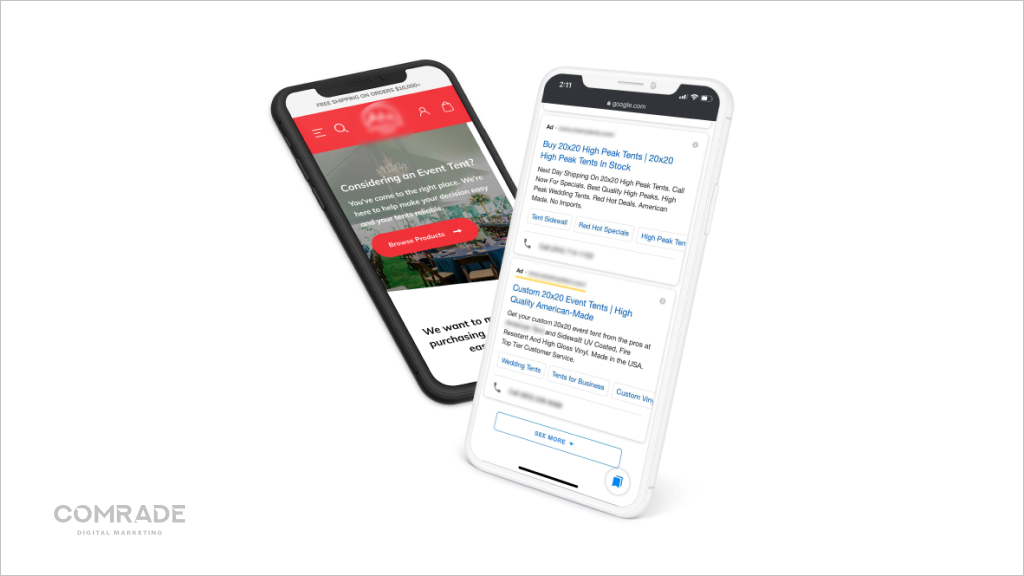
Our mission is to craft and manage PPC campaigns that are affordable, relevant to our client’s target audience, and deliver results. Simple as that. We’re pros at leveraging all tools at our disposal to keep ahead of the latest algorithms, bid effectively for the right keywords, and ensure smooth management of your campaign.
4. Cross Channel Ads & Retargeting Ecommerce Services
We are more than an eCommerce PPC agency. Guided by your unique selling needs and market research, we will set up and manage your PPC campaign across all major search and social networks including Google, Facebook, YouTube, Instagram, Display, Shopping campaigns, or Bing, to name a few.
5. Ecommerce PPC Management & A/B Testing
As part of our ongoing eCommerce PPC management, we’ll constantly test ad copy, calls-to-action, targeting, and destination pages until we lock in the right formula to maximize conversions and keep your PPC spend to a minimum. The goals of the eCommerce business are the main point to decide which type of paid advertising we will use.
6. Ecommerce Tracking and Measuring Success
We believe in transparency and accountability. Every step of your ecommerce PPC service with us will be monitored to ensure progress. You’ll have access to custom reports measuring your PPC results alongside your unique growth metrics and revenue goals. We think that analytics is key to successful marketing services for ecommerce businesses.

Grow your Online Store with Comrade’s eCommerce PPC Services
Comrade’s eCommerce PPC services have a proven track record of generating a meaningful return on your investment. In fact, our PPC campaigns average a $4.50 return on every $1 you spend. Want to get ahead of the competition? Then call us on (312) 265-0580 or contact us here.
I've never had a PPC campaign setup before. Can you help?
Absolutely. Our digital marketing team has vast experience in executing highly successful paid advertising campaigns. Let’s start with an assessment of your business goals and walk you through how PPC works. Setting up an effective campaign is painless and cost-effective!
Is paid search effective for Ecommerce stores?
Without a doubt, it is highly effective. Research indicates that 64% of people click on PPC ads (and thereby land directly on your website) over organic search engine results. That’s an impressive number. What’s more, you only pay for those clicks, making PPC a very affordable option that delivers a substantial return on ad spend. Our PPC campaigns average a $4.50 return on every $1 spent.
How long does it take to generate results with Ecommerce PPC management service?
Most of our clients start seeing meaningful results within the first month. For some clients selling more complex products or services, it may sometimes take two months to generate those results.





